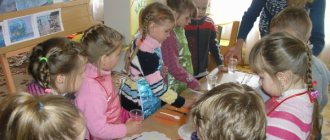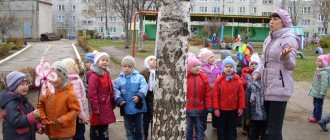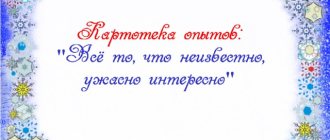CHILDHOOD GUIDE
One of the areas of cognitive development of preschoolers is the formation of their natural scientific ideas about the world around them. It is recommended to begin work in this area purposefully and systematically from early preschool age. It is during this period that the foundation of a conscious attitude towards the world around us is laid, and vivid emotional impressions are accumulated.
The tasks of forming the cognitive and research activities of children of the younger group: - to develop the ability to establish the simplest connections and relationships to objects in the immediate environment; — enrich the knowledge of preschoolers with new impressions; - promote the development of cognitive interest in the world around us.
Approximate thematic planning of cognitive and research activities with children of the younger group
The work is carried out during observations on walks, during games-experiments with natural materials or in the form of role-playing games, in independent activities of children.
1. Our square. Tasks and content: Consider autumn trees: rowan, birch. Identify the characteristic features - on birch they are small and round, on rowan they are large and long, oblong. 2. Gifts of autumn. Tasks and content: Observing the movement of air - the wind blows and tears leaves from the trees, the leaves swirl in the air. Collect bouquets of colorful leaves. You can offer to throw bouquets up “let’s make fireworks.” Admire the multi-colored carpet that has formed on the ground. 3. Let's walk on a carpet of leaves. Objectives and content: Continue to form the concept that with the arrival of cold weather, leaves dry out, fall from the trees and rustle underfoot. Walk on a rustling mat of dry leaves. Tell that the wind also knows how to play with dry leaves. Listen to the wind rustle the leaves. 4. Decorate the sandbox with autumn leaves. Objectives and content: Reinforce in children the names of primary colors: green, yellow, red. Continue to form the concept of the size of a “big-small” leaf in the process of laying out a pattern of multi-colored leaves. 5. Experimental game: “Drowning - not drowning.” Objectives and content: Determine the degree of buoyancy of objects of different weights. The leaves are light - they float like boats. Check if the stones will float? Find out the cause-and-effect relationship. 6. Gifts of autumn. Tasks and content: Reinforce the name of the main colors of autumn leaves. Make a garland of leaves and decorate the group. 7. Experimental game: “Which boat is faster?” Objectives and content: Observation of the strength and work of the wind. Make boats from leaves and paper. Find out together with the children which boat the wind will carry away further - from a piece of paper or from paper? 8. Journey of a droplet. Objectives and content: To reinforce the signs of autumn in children: when it rains, the paths become wet, damp, and there are puddles on the ground. Pay attention to the size of the puddles: large and small. 9. Let's build a slide from loose sand. Objectives and content: Introduce the concept of “loose”: slowly pour sand into a cone and watch how the grains of sand fall down. 10. Sand can run. Objectives and content: To introduce children to the properties of dry sand - it “runs” down, “slides” from a height. Take dry sand in your hands and slowly release it from the fist in a stream, so that the stream of sand falls in one place. A hillock is formed. Watch the sand slowly run down from the top. 11. Footprints in the sand. Objectives and content: Explain to children that wet sand leaves footprints. Damp sand does not fall. Traces from the mold remain on the wet sand. And the palm leaves a mark, and the shoe, and the boots. 12. Let's see grains of sand. Objectives and content: Introduce children to a magnifying glass. Tell that sand consists of individual grains of sand, they can be seen, the grains of sand are different in shape and size. 13. We sculpt from wet sand. Objectives and content: To introduce children to the peculiarity of wet sand: it molds, but dry sand does not. Invite the children to make large and small koloboks. 14. Gifts from our forest. Objectives and content: Introduce the fruits of the forest. Consider the structure of spruce and pine cones. Compare leaves and cones of spruce plants. 15. Gifts from our site. Such different stones. Objectives and content: Reinforce the concept: heavy and light. Invite the children to find pebbles in the sandbox and examine them: they are all different, large and small, round and oblong. Check which pebble will sink faster: big or small? 16. Gifts from our site. Such different stones. Objectives and content: Reinforce the concept: wet - dry. Invite the children to find pebbles in the sandbox and put them in a bucket of water. Find out what happened to them. What kind of stones did they become? 17. Colored droplets. Objectives and content: Find out with children the properties of water. Show children that water can have colors. Using a brush or pipette, tint the water to create different colors. 18. Such different dishes. Objectives and content: Show children that dishes are made of various materials: metal, clay, wood, plastic, glass. Consider various examples of tableware. Prove that the dishes are fragile and may break. 19. Secrets of different rings. Objectives and content: To introduce children to rings of various shapes and sizes (car wheels, bagels, dryers). Conduct examinations and experiments with dough or plasticine. 20. Such different patterns. Objectives and content: Examine frost patterns on glass with children. Offer to breathe on the glass, place your palm on the glass. 21. Gifts of winter. Footprints in the snow. Tasks and content: Observe freshly fallen snow. Examine the footprints in the snow, offer to guess who came to the site? Who left the path? (bird, dog, person). 22. Such different koloboks. Objectives and content: Draw children’s attention to the fact that snow melts in warmth. Add 2 lumps of dough and snow, place in a warm place. After the walk, check what happened to them? Where did the snowball go? 23. Gifts of winter. Magic ice floes. Tasks and content: Observe water in the cold. Find out that water turns into ice in cold weather. Take the molds out to the area and fill them with colorful water. Watch what happens? Decorate the area with multi-colored ice floes. 24. Gifts of spring. Funny icicles. Objectives and content: Prove that when snow melts, icicles form under roofs. Examine them: transparent, slippery, like glass. Hold pieces of icicles in your palms. Find out that a warm palm will melt an icicle. 25. Gifts of spring. Happy streams. Objectives and content: To introduce children to the signs of spring. The warm sun melted the snow and turned into streams. Play the game - launch a paper boat into a stream. 26. Big wash. Objectives and content: Find out with the children that not everything can be washed in water. Offer to wash the dress for Katya doll. First a dress made of fabric, and then a dress made of paper. Analyze the result. 27. Games with soap foam. Objectives and content: Show children that soap foams. Learn how to whip foam. Hold a competition to see who can make the foam higher and fluffier. 28. Guests of our yard. Tasks and content: Observe the dog. Find out what food she eats, how she runs, and wags her tail. 29. Guests of our yard: Who flew to the site? Objectives and content: Conduct bird observation. Find out the characteristic features of pigeons and sparrows. 30. Guests of our yard. Our cat. Objectives and content: Observing the habits and behavior of the cat. What can a cat do? (Play, walk, run, purr, sleep, squint in the sun). What food does she eat? 31. Gifts of spring. Sunny bunnies. Objectives and content: Play a game with a mirror. “Catch” a sunbeam, bring pleasure to children, evoke positive emotions. 32. Our aquarium. Objectives and content: To introduce the habitat of aquarium fish. Consider the appearance of the fish. Tell us how to care for fish. 33. Our garden. Tasks and content: Plant vegetables and herbs with the children. See what grows faster? Find out the necessary conditions for the growth of vegetables.
Dear teachers! If you have questions about the topic of the article or have difficulties in working in this area, then write in the comments. I'll definitely help.
Golovina Bela Gennadievna, site administrator. Planning cognitive and research activities in the middle group of a preschool educational institution Planning of cognitive and research activities in the senior group of a preschool educational institution The importance of theatrical and gaming activities in the second junior group Role-playing games in the second junior group of a preschool educational institution >
HUMAN
Cheerful men playing
Introduce the structure of the human body: torso, legs, arms, feet, fingers, neck, head, ears; face – nose, eyes, eyebrows, mouth; hair. A set of toys (a naked doll, a fish, any animal, a bird), a “wonderful bag”, a mirror, dummies of human body parts (torso, legs, arms, feet, neck, head). An adult invites the children to play the game “Wonderful Bag”: find a little man (naked doll) in the bag by touch. Children take turns completing the task and explain to the adult how each of them found out that this is a man (he has a torso, two arms, a head, etc.), and why he didn’t choose another toy (it has a tail, wings and etc.), for emotional living and to intensify the examination of the body, you can play the musical game “Where, where are ours...” (name of body parts) and “Measurements”, when children measure themselves and find out who has longer or shorter legs and arms , who is taller). You can also offer the game “Show (do) what I say” (jump on one leg, show your ear, etc.).
Fabric, its qualities and properties
To teach to recognize things made of fabric, to determine its qualities (thickness, surface structure, degree of strength, softness) and properties (creases, cuts, tears, gets wet, burns). Samples of cotton fabric in two or three colors, scissors, alcohol lamp, matches, containers of water, algorithm for describing the properties of the material. Children play with dolls dressed in cotton dresses. The adult invites the children to think about what the dresses are made of; what color is the fabric; What else do they know about this material? Offers to determine the qualities and properties of fabric. Each child takes a piece of fabric of the color they like, feels it, reveals the surface structure and thickness. He crumples the fabric in his hands (crumples), pulls two opposite edges (stretches); cuts the piece into two parts with scissors (cuts); dips a piece of fabric into a container of water (gets wet); compares changes in fabric in water with wet paper (fabric retains its integrity better than paper). An adult demonstrates how fabric burns and tears under strong tension. Together with the children, he creates an algorithm for describing the properties of the material.
Clay, its qualities and properties
Teach to recognize things made of clay, determine its qualities (softness, plasticity, degree of strength) and properties (crumples, breaks, gets wet). Clay objects, pieces of clay, water, work stands, containers, an algorithm for describing the properties of the material. An adult organizes an exhibition of clay toys. After examining it with children, he finds out what all the toys are made of; what material was used; What else would children like to know about him? Then he offers them stands with pieces of clay lying on them and asks what can be molded from them and why. Children roll a ball (the clay is soft, plastic, it can be crushed: make a cake from the ball, etc.). Place a small piece of clay in a container of water and watch it soak. An adult demonstrates how a clay toy breaks easily. Together with the children, he creates an algorithm for describing the properties of the material.





